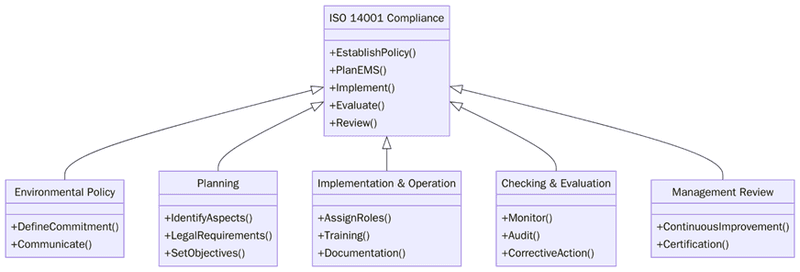What is ISO 14001 Compliance and Carbon Footprint Reduction?

Introduction
Environmental responsibility has moved to the centre of global business expectations. Organizations across industries are expected to manage emissions, reduce waste and operate with a clear commitment to sustainability. ISO 14001 offers a structured Environmental Management System (EMS) that helps institutions understand environmental impacts, establish responsible practices and improve their performance over time. It supports organizations in reducing carbon emissions, conserving resources and demonstrating environmental accountability to customers, regulators and global partners.
Carbon footprint reduction is one of the strongest outcomes of ISO 14001 implementation. The standard helps institutions measure energy use, assess emissions, track waste generation and implement strategies that minimize negative environmental effects. As environmental reporting becomes more important for supply chain acceptance and long-term competitiveness, institutions with ISO 14001 compliance gain a stronger position in both local and international markets.
Start your environmental certification journey with Pacific Certifications, an accredited body offering global ISO 14001 audits.
Quick summary
ISO 14001 is the international standard for environmental management systems. It helps organizations identify environmental aspects, establish control measures, reduce carbon emissions and implement effective monitoring. Through structured evaluation, clear objectives and ongoing system improvement, ISO 14001 strengthens environmental performance and supports long-term sustainability.
Why ISO 14001 compliance is important?
Environmental transparency and responsible operations are becoming decisive factors in institutional credibility. ISO 14001 enables organizations to understand their environmental impact and implement structured controls to reduce emissions and resource consumption. It establishes accountability at every level and promotes responsible decision-making.
By linking planning, monitoring and environmental objectives, ISO 14001 ensures organizations minimize their impact while supporting operational continuity.
“ISO 14001 provides a practical way for organizations to reduce their environmental footprint and build trust through measurable environmental performance.”
Table: ISO 14001 and Carbon Footprint Reduction Overview
Focus Area | What It Supports | Impact on Carbon Reduction |
Environmental aspects | Identifying key impacts | Better emission and waste control |
Operational controls | Daily environmental management | Lower energy and resource use |
Monitoring and measurement | Tracking performance data | Improved carbon reporting |
Life cycle perspective | Evaluating product and service impact | Reduced footprint across supply chain |
Continual improvement | Updating plans and objectives | Long-term reduction in emissions |
What are the requirements for ISO 14001 compliance?
ISO 14001 requires institutions to establish a structured EMS that supports environmental responsibility and carbon footprint reduction. Below are the key requirements:

- Define the scope of the Environmental Management System.
- Identify environmental aspects and their potential impacts.
- Establish an environmental policy aligned with organizational goals.
- Determine compliance obligations and regulatory requirements.
- Set measurable environmental objectives and targets.
- Allocate resources and define roles for EMS operations.
- Maintain documented procedures, controls and operational criteria.
- Implement monitoring and measurement tools for environmental performance.
- Conduct internal audits to review EMS effectiveness.
- Carry out management reviews for ongoing system evaluation.
- Implement corrective actions where issues are identified.
- Sustain continual improvement through planned updates.
Tip:Maintain a real-time dashboard for energy use, emissions and waste metrics to make corrective actions accurate and timely.
How to prepare for ISO 14001 compliance?
Successful preparation requires a clear understanding of current environmental performance and aligning it with ISO 14001 requirements. Institutions must build consistent documentation and evaluate risks through structured assessments.
1. Conduct a gap analysis against ISO 14001 expectations.
2. Develop or update the environmental policy.
3. Create an aspect-impact register.
4. Implement training for staff on environmental responsibilities.
5. Establish monitoring systems for energy and resource consumption.
6. Conduct internal audits to identify missing controls.
7. Hold management review meetings prior to certification.
Certification audit
Stage 1 audit: Reviews environmental documentation, objectives and existing controls.
Stage 2 audit: Verifies real implementation across departments and operations.
Nonconformities: Must be resolved with evidence before certification approval.
Management review: Ensures leadership oversight in environmental planning and monitoring.
Final certification: Issued once all requirements are met.
Surveillance audits: Conducted annually to ensure sustained performance.
Recertification audits: Required every three years to maintain EMS validity.
What are the benefits of ISO 14001 and carbon footprint reduction?
ISO 14001 provides measurable advantages through stronger environmental controls and reduced emissions. Before experiencing these outcomes, organizations often benefit from clearer documentation, structured reporting and improved operational consistency.
Below are the key benefits:
1. Reduced carbon emissions through structured environmental planning
2. Better energy efficiency and lower resource use
3. Improved compliance with environmental requirements
4. Stronger trust among customers, partners and regulators
5. Lower environmental risks and fewer operational disruptions
6. Better integration with sustainability and ESG reporting
7. Stronger decision-making supported by environmental data
8. KPIs: energy use reduction rate, waste diversion rate, emissions trend, audit closure cycle
9. SLAs: corrective action turnaround time, environmental data reporting cycle, review meeting frequency
Market Trends
Organizations are increasingly using digital tools to monitor emissions, track energy use and evaluate waste patterns. Environmental performance is being linked with supply chain requirements, ESG disclosures and green procurement. Automated monitoring systems, life cycle analysis tools and sustainability dashboards are becoming part of standard environmental practices.
Environmental regulations and reporting expectations will continue to grow globally. Institutions with strong ISO 14001 systems will be better prepared to meet supply chain pressures and sustainability benchmarks. Future developments will include AI-enabled emissions forecasting, sensor-driven environmental monitoring and automated reporting systems that support transparent environmental performance.
Training and courses
Pacific Certifications offers accredited training for ISO 14001:
· Lead Auditor Training: For professionals conducting environmental audits and performance evaluations.
· Lead Implementer Training: For individuals establishing or improving Environmental Management Systems.
To schedule ISO 14001 training, contact [email protected].
How Pacific Certifications can help?
Pacific Certifications provides accredited ISO 14001 certification and audit services. Our audits evaluate environmental controls, performance monitoring and alignment with ISO 14001 requirements. We issue Certificates of Conformity after impartial certification audits, without providing consultancy services.
For an environmental audit roadmap or certification proposal, contact [email protected] or visit www.pacificcert.com.
Ready to get ISO 14001:2015 certified?
Contact Pacific Certifications to begin your certification journey today!
Author: Alina Ansari
Suggested Certifications –
Read more: Pacific Blogs

